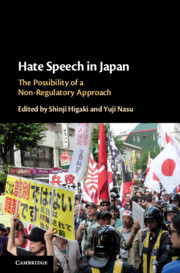Book contents
- Hate Speech in Japan
- Hate Speech in Japan
- Copyright page
- Contents
- Tables
- Figures
- Contributors
- Acknowledgements
- Abbreviations
- Introduction
- Part I Outline
- Part II History
- 4 Buraku Discrimination and Hate Speech
- 5 The Current Movement of Hate Speech
- 6 The Failure of the Human Rights Vindication Bill
- Part III Legal Framework
- Part IV Cases
- Part V Multidisciplinary Debates
- Part VI Current Issues
- Book part
- Index
4 - Buraku Discrimination and Hate Speech
Complex Situations of Classical and Contemporary Discrimination in Japan
from Part II - History
Published online by Cambridge University Press: 15 January 2021
- Hate Speech in Japan
- Hate Speech in Japan
- Copyright page
- Contents
- Tables
- Figures
- Contributors
- Acknowledgements
- Abbreviations
- Introduction
- Part I Outline
- Part II History
- 4 Buraku Discrimination and Hate Speech
- 5 The Current Movement of Hate Speech
- 6 The Failure of the Human Rights Vindication Bill
- Part III Legal Framework
- Part IV Cases
- Part V Multidisciplinary Debates
- Part VI Current Issues
- Book part
- Index
Summary
In this chapter, we examine the problem of Buraku discrimination – a traditional type of discrimination specific to Japan of which few Japanese people are aware. Similar to, but not the same as, the caste system in South Asia, Buraku were areas in which those involved in certain occupations considered distasteful were required to reside. At its most simple, the Burakumin (‘Buraku people’) are those descended from those living in these areas, but Buraku discrimination is more complex than this. The United Nations CERD has called on the Japanese government to address the issue of Buraku discrimination and the government asserts that it is fully committed to doing so. However, traditional Buraku discrimination is now manifesting as hate speech and online discrimination. The Dowa policy – a special measure that had aimed to tackle the issue – ended in 2002 and no new measures were put in place until 2016, when an Act for Eliminating Discrimination against Buraku was finally passed. This chapter focuses on three incidents that occurred in the 2000s as instances of hate speech and clarifies the modern characteristics of Buraku discrimination.
Keywords
- Type
- Chapter
- Information
- Hate Speech in JapanThe Possibility of a Non-Regulatory Approach, pp. 107 - 124Publisher: Cambridge University PressPrint publication year: 2021



